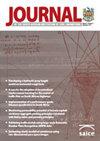Understanding the barriers and drivers of sustainable construction adoption and implementation in South Africa: A quantitative study using the Theoretical Domains Framework and CQM-B model
IF 0.6
4区 工程技术
Q4 ENGINEERING, CIVIL
Journal of the South African Institution of Civil Engineering
Pub Date : 2021-12-31
DOI:10.17159/2309-8775/2021/v63n4a2
引用次数: 1
Abstract
The construction industry is one of the largest consumers of natural resources. Improving the sustainability of construction industry activities is therefore key to mitigating the negative impact of the industry on the environment. Given the extent of the environmental challenges faced by many countries, the transition towards the adoption of sustainable alternatives in the construction industry must include dimensions of changing human behaviour. These dimensions include influencing the capability, opportunity, and motivation to adopt the desired change in behaviour. In order to improve the adoption and implementation of sustainable practices within the construction industry, the behaviour change processes of stakeholders need to be considered. This study describes how the Capability, Opportunity, Motivation-Behaviour (COM-B) model and Theoretical Domains Framework (TDF) were used to identify the barriers to and drivers of sustainable construction practices by construction industry stakeholders. The study included a structured questionnaire survey completed by 108 construction industry stakeholders and indicated a need to improve the capability, opportunity, and motivation amongst construction industry stakeholders to facilitate the adoption of sustainable construction practices. The questionnaire identified that an increase in the awareness, knowledge, interest, and demand for sustainable construction will facilitate the adoption thereof. Additionally, providing training and access to education on best practices for sustainability can positively influence the behaviour of stakeholders and improve their confidence in implementing sustainable construction practices. Economic factors such as the cost of implementing sustainable solutions and the perception of the economic and social benefits of sustainable construction were identified as the critical barriers. These barriers and drivers are mapped to five TDF domains (knowledge, skills, social influences, beliefs about capabilities, and beliefs about consequences), which can be targeted for behaviour change amongst construction industry stakeholders in future interventions.理解南非可持续建筑采用和实施的障碍和驱动因素:使用理论领域框架和CQM-B模型的定量研究
建筑业是自然资源的最大消耗者之一。因此,改善建造业活动的可持续性是减轻建造业对环境的负面影响的关键。鉴于许多国家所面临的环境挑战的程度,在建筑行业向采用可持续替代品的过渡必须包括改变人类行为的各个方面。这些维度包括影响能力、机会和动机,以采用期望的行为改变。为了改善建筑行业内可持续实践的采用和实施,需要考虑利益相关者的行为改变过程。本研究描述了如何使用能力、机会、动机-行为(COM-B)模型和理论领域框架(TDF)来识别建筑业利益相关者可持续建筑实践的障碍和驱动因素。这项研究包括一份由108名建造业持份者完成的结构化问卷调查,结果显示建造业持份者需要提高能力、机会和动机,以促进采用可持续的建筑做法。问卷调查发现,对可持续建筑的意识、知识、兴趣和需求的增加将促进可持续建筑的采用。此外,提供关于可持续发展最佳做法的培训和教育,可以对利益相关者的行为产生积极影响,并提高他们对实施可持续建筑做法的信心。经济因素,如实施可持续解决方案的成本和对可持续建筑的经济和社会效益的认识,被认为是关键的障碍。这些障碍和驱动因素被映射到五个TDF领域(知识、技能、社会影响、对能力的信念和对后果的信念),这些领域可以作为未来干预措施中建筑业利益相关者行为改变的目标。
本文章由计算机程序翻译,如有差异,请以英文原文为准。
求助全文
约1分钟内获得全文
求助全文
来源期刊
CiteScore
0.70
自引率
25.00%
发文量
19
审稿时长
>12 weeks
期刊介绍:
The Journal of the South African Institution of Civil Engineering publishes peer reviewed papers on all aspects of Civil Engineering relevant to Africa. It is an open access, ISI accredited journal, providing authoritative information not only on current developments, but also – through its back issues – giving access to data on established practices and the construction of existing infrastructure. It is published quarterly and is controlled by a Journal Editorial Panel.
The forerunner of the South African Institution of Civil Engineering was established in 1903 as a learned society aiming to develop technology and to share knowledge for the development of the day. The minutes of the proceedings of the then Cape Society of Civil Engineers mainly contained technical papers presented at the Society''s meetings. Since then, and throughout its long history, during which time it has undergone several name changes, the organisation has continued to publish technical papers in its monthly publication (magazine), until 1993 when it created a separate journal for the publication of technical papers.

 求助内容:
求助内容: 应助结果提醒方式:
应助结果提醒方式:


